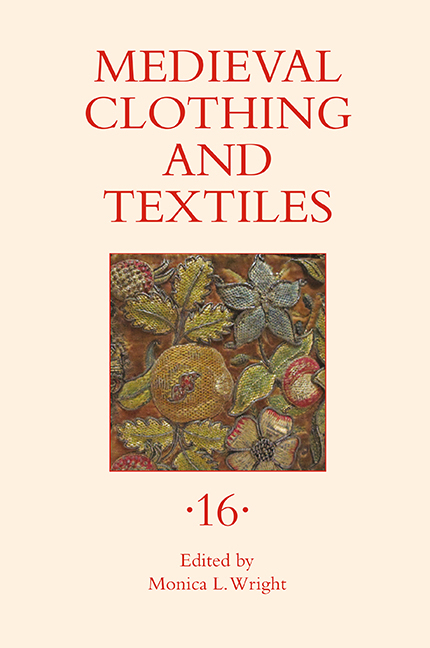Book contents
- Frontmatter
- Contents
- Illustrations
- Tables
- Contributors
- Preface
- 1 Anglo-Saxon Banners and Beowulf
- 2 The Use of Curved Templates in the Drawing of the Bayeux Tapestry
- 3 Construction and Reconstruction of the Past: The Medieval Nordic Textile Heritage of Hemp
- 4 Historicizing the Allegorical Eye: Reading Lady Mede
- 5 Sex, Lies, and Verdugados: Juana of Portugal and the Invention of Hoopskirts
- 6 Fashion and Material Culture in the Tabletop of the Seven Deadly Sins Attributed to Hieronymus Bosch
- 7 The Broderers’ Crown: The Examination and Reconstruction of a Sixteenth-Century City of London Livery Company Election Garland
- Appendix 7.1 Surviving Sixteenth-and Seventeenth-Century Embroidered Crowns of the City of London Livery Companies
- Recent Books of Interest
- Author Index, Volumes 1–15
6 - Fashion and Material Culture in the Tabletop of the Seven Deadly Sins Attributed to Hieronymus Bosch
Published online by Cambridge University Press: 27 March 2021
- Frontmatter
- Contents
- Illustrations
- Tables
- Contributors
- Preface
- 1 Anglo-Saxon Banners and Beowulf
- 2 The Use of Curved Templates in the Drawing of the Bayeux Tapestry
- 3 Construction and Reconstruction of the Past: The Medieval Nordic Textile Heritage of Hemp
- 4 Historicizing the Allegorical Eye: Reading Lady Mede
- 5 Sex, Lies, and Verdugados: Juana of Portugal and the Invention of Hoopskirts
- 6 Fashion and Material Culture in the Tabletop of the Seven Deadly Sins Attributed to Hieronymus Bosch
- 7 The Broderers’ Crown: The Examination and Reconstruction of a Sixteenth-Century City of London Livery Company Election Garland
- Appendix 7.1 Surviving Sixteenth-and Seventeenth-Century Embroidered Crowns of the City of London Livery Companies
- Recent Books of Interest
- Author Index, Volumes 1–15
Summary
A tabletop painted about 1505–10 and signed with the name Hieronymus Bosch (ca. 1450–1516) vividly depicts the seven deadly sins as they might play out in everyday life. These are arranged in wedges or sections within a circle (fig. 6.1). Three of these failings—Envy, Pride, and Lust—are associated more than the other four shown in the painting with fashionable clothing and high-status material culture in late medieval moralizing literature and art. Thus, close and historically grounded study of these three sections can reveal how the artist skillfully presented certain clothing styles (and forms of decor) as eagerly desired by those wishing to present themselves as of high status, but outmoded and ultimately understood as valueless by wiser beholders who recognize the fickleness of fashion. Though past treatments of the tabletop have seen there a general striving for status, revisiting its clothing and settings in a more comparative way, with a detailed analysis of the clothing, will unlock additional meaning in the tabletop by giving modern viewers a chance to see it with more of its original context intact. This context is crucial, because the artist examines the wages of Envy, Pride, and Lust among the upper classes through contemporary kleider-kritik rather than with eschatological regard to the fires of hell, though such infernal punishment is vividly shown in one of the four corner medallions, with individual sins labeled and punished appropriately.
The few definite facts known about the Dutch artist Hieronymus Bosch's life and career largely relate to the tensions in social class and mobility in Northern European society particularly associated with the three sins just mentioned. Like the Flemish manuscript miniaturist Simon Bening, Bosch married upward; his wife, Aleid van de Meervenne, was somewhat better off financially and higher socially than Bosch's family. Through this marriage and his artistic commissions he acquired rental property and could be counted among the well-to-do burghers and successful artisans in ‘s-Hertogenbosch, a small city in the southern Netherlands near the modern Dutch-Belgian border which was then a vibrant center of commerce and manufacturing.
- Type
- Chapter
- Information
- Medieval Clothing and Textiles 16 , pp. 123 - 162Publisher: Boydell & BrewerPrint publication year: 2020



